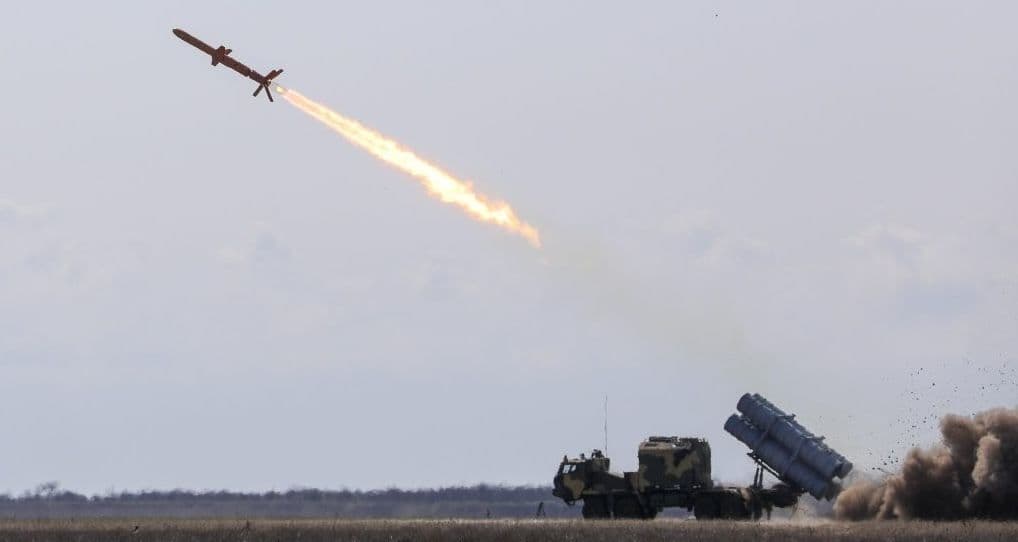
Why Ukraine’s long-delayed missile production ambitions have yet to get off the ground
Ukraine is rapidly expanding its arsenal to strike back at Russia, but domestic production of traditional ballistic and cruise missiles faces delays. Can a war-battered Ukrainian defense industry build a new generation of long-distance strike missiles?
A Ukrainian-made Neptune-derived cruise missile is fired from an unspecified location on April 5, 2019. (Presidential Office of Ukraine)
The Ukrainian government in recent months has been aggressively touting fresh developments in its missile-making.
President Volodymyr Zelensky announced that the country had built 100 of its own missiles in 2024 as of November. He called for 3,000 “cruise missiles or missile-drones” to be manufactured in 2025.
Traditional missiles are tricky. Ukraine’s notable successes in scaling up drone production were to a large degree a workaround of the country’s limits in defense industry autonomy. Russia and the West gutted Ukraine’s weapons factories after the fall of the USSR, with the help of local corruption. Those that remain are subject to constant Russian bombardment.
As a result, analysts call Zelensky’s figures and the claimed features of traditional missiles made at home an oversell.
“If Ukraine can only deliver half of what Zelensky promised at the end of 2024 in terms of missile and drone production, I will be very content. But that's going to be challenging,” says Fabian Hoffmann, a missile expert and research fellow at the Oslo Nuclear Project.
Ukraine’s budding missile program joins a long tradition of metaphorical and literal saber-rattling between hostile armies. For the time being, the missiles have yet to prove themselves on the battlefield. The challenge for outside observers is in sorting out ballistics from bluster.
Here is what we know and can assess of the roster of Ukraine’s home-grown missiles today.
The Neptune, a nautical cruise missile
Originally designed to hit ships from coastal positions, the Neptune has been converted into a cruise missile that can be launched from land, per Ukrainian authorities. It is what Hoffmann calls “by far the most mature of these large missile projects.”
Ukrainian officials said it was a Neptune that struck and sank the Russian cruiser Moskva back in April 2022. An unnamed official told the War Zone that they had reconfigured the Neptune to strike and disable an S-400 Russian air defense battery back in August 2023.
Various Ukrainian Telegram channels cited anonymous sources saying that the Neptune was used to hit a Russian ammunition depot in Rostov Oblast on Jan. 11.
But evidence of Neptunes flying is largely limited to government statements or citations of unnamed officials. That is despite Zelensky touting that the Neptune had been “accepted into weaponry” in a speech to Ukraine’s Parliament all the way back in 2020.
“There were discussions that Ukraine would set up production for at least the anti-ship cruise missiles,” says Hoffmann.
“Initially we heard that they were very artisanaly producing them — just a couple per month at most, but there was not really a production line. But there was this assumption that Ukraine would be able to streamline that to some extent. And that obviously hasn't happened, at least if we derive it from the rate of usage which really hasn't seen any kind of uptick since 2023.”
Thunder 2, the ballistic variant
Distinct from the cruise missile Neptune, the Hrim 2 — or Thunder 2 in English — is a ballistic rocket program, based on solid fuel and inertial guidance and in theory reaching speeds several times that of sound.
Unlike a cruise missile, a ballistic missile goes far into the atmosphere, with many traveling at speeds many times that of sound.
The program goes back as far as 2006 under the name Sapsan, which at some point became the internal name, as opposed to the envisioned international export model, the Hrim 2.
Ukrainian officials said that the Hrim 2 finally passed testing toward the end of 2024, with Zelensky announcing “positive results” in August. The head of the permanent Ukrainian delegation to NATO, Yehor Cherniev, said of the Hrim 2s in October: “Here, believe me, there will soon be concrete results that not only Ukraine, but the Russian Federation will see.”
“I’m seeing test launch claims from last year but, eh,” says Michael Duitsman, a missile specialist at the Middlebury Institute in California, doubtfully, about the Hrim 2.
Korshun and Vilcha: Lost en route to market
Two projects, the Korshun and Vilcha — respectively a cruise missile and multiple-launch rocket system — were the subject of extensive press speculation in the mid- to late-2010s.
The Korshun was a cruise missile, a scale model of which was getting dragged around weapons conferences a decade ago. Despite being a cruise missile, one pro-Russian Telegram channel in 2017 named it as the basis for the Hrim 2. The Korshun project has effectively been shelved since Zelensky’s election.
The Vilcha is an updated Soviet rocket complex that promised to use modernized, Ukrainian-made rockets with higher precision than its predecessor. Despite appearing in Ukrainian military parades as far back as 2018, there’s been no evidence of a functional system playing a role since the full-scale invasion.

In the same speech in which he promised “concrete results” for the Hrim 2, Cherniev noted certain components of the Vilcha that “unfortunately, we won’t be able to get quickly,” without specifying what those components were.
Various other projects like the volunteer-based “Trembita” are described as “cruise missiles,” including in reports from the Economist and the Telegraph, but have nowhere near the speed, range, or payload to merit that title as it is generally understood, maxing out at 400 kilometers/hour, 200 kilometers, and 20 kilograms in each field, respectively..
“If you throw a rock fast enough you can call it a missile,” says James Acuna, a former naval architect and CIA officer in Eastern Europe, currently consulting on drone production from Estonia, about the Trembita.
Why a missile program is so hard to build
The main distinction between making classic cruise or ballistic missiles and, for example, Ukraine’s “missile-drones,” which the Trembita more closely resembles, is that the lighter and slower missile-drones can be made in smaller facilities with a far larger proportion of off-the-shelf commercial components.
The production of those more advanced engines, guidance systems, and fuel for more traditional missiles requires bigger permanent facilities and massively more precise engineering.
“This is like another level of science and engineering and physics,” says Acuna. “Ukraine does not currently have the military-industrial complex to make missiles. Can they make a good Frankenstein missile? Sure, they can do that, but is it going to take down a Kh-31?”
Designed during the USSR, the Kh-31 is an air-launched missile that hits Mach 3.5 and still sees regular use in the Russian military.
Duitsman for one doesn’t think the problem is Ukrainian technological savvy so much as Russian air attacks. “Once you get the basic industry down it’s not that hard, it just becomes immensely harder when someone is trying to bomb all of your factories.”
Unlike the small workshops in which Ukrainians can produce drones, the factories involved in missile production are massive and their locations well-known. Many Russians still alive once worked in them during the Soviet Union. For the duration of the war, Russian airstrikes have targeted them avidly.
In the first months of the war, Russia blew up a massive stockpile of solid rocket fuel in a chemical plant in Pavlohrad, on the western edge of the Donbas.
Following a Dec. 20 attack on Kyiv, the Russian Defense Ministry said it had hit “the construction bureau ‘Luch,’ which has accomplished planning and production of rocket complex ‘Neptune’ and the land-based guided rocket complex ‘Vilcha.’”

And on Jan. 8, Russia bombarded the Ukrainian city of Zaporizhzhia with glide bombs, resulting in the death of some 13 people and 113 more injured. Among the targeted areas, photos from the national police show damage to a “Motor Sich” factory that has long produced jet engines, including the MS400 Turbofan engines that at least at some point powered the Neptune.
Given such security threats it is not surprising that Ukraine has been secretive in details about its missile program. When reached, a representative for the Strategic Industries Ministry declined to comment, calling it “a sensitive subject.”
Still, little has been seen of these missiles in action, casting great doubt on Ukraine’s actual production. Mass use within Russia would almost certainly have ended up on social media via Russians under bombardment. Despite the secrecy, Ukraine is obviously eager to tout successes in these missile programs.
Why flaunt a missile program
The development of a local missile program would allow Ukraine to strike back at Russia directly, freed from Western terms for donated weaponry. Missiles have also become more intangible symbols of independence.
Eastern Ukraine was the heartland for much of the Soviet Union’s heavy industry. Yuzhnomash in Dnipro was the “largest ICBM factory in the world,” notes Duitsman.
After the breakup of the Soviet Union, Ukraine’s missile production was dismantled and cannibalized. The government has spent 20 years claiming that a rocket renaissance is at hand.
Renamed to Pivdenmash — a shift from the Russian to Ukrainian word “pivden” meaning “south” — the same factory remains an epicenter of Ukraine’s weapons production, including the Hrim itself.
As with many such plants, Pivdenmash is a target for Russian missile attacks, including the infamous strike by Russia’s new Oreshnik on Nov. 21, an event that had many Western observers wringing their hands over the world’s first launch of an ICBM.
Ukraine is hardly alone in treating missiles as fonts of national pride. U.S. military sources were positively gleeful in touting the Patriot air defense missile’s success in shooting down Russia’s hypersonic Kinzhal in May 2023.
Russia has often bragged about weapons developments beyond their utility. The Russian Oreshnik that struck Pivdenmash in November, for example, was far less impressive than the headlines it managed to gather, says Duitsman.
The Oreshnik, he argues, was a fairly minor adaptation of a prior missile that was touted as novel based on the maker’s advertising and President Vladimir Putin’s sudden desire to cause a stir after the U.S. and U.K. permitted Ukraine to strike some Russian territory.
“States are not monoliths. Russia does not as a whole choose to pursue different missile programs,” says Duitsman.
“These are the results of conflicting political, military, industrial, and engineering goals. The Oreshnik does not necessarily make sense in a military context. It does make sense in the context of these missile design bureaus and missile production factories wanting a piece of the sweet sweet war money pie.”
Ukraine seems likewise to be overselling the tangible results of local missile development, Hoffmann says. “They have a vested interest in making it look like they're doing well,” as Duitsman puts it.










